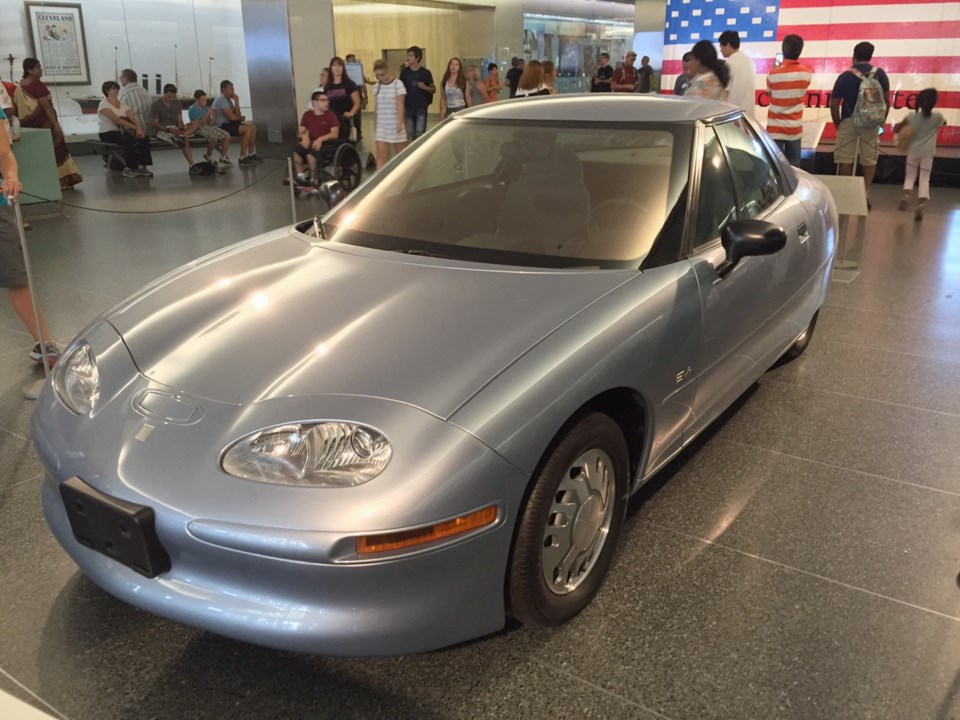General Motors knew the electric automotive age was coming when it showed its Impact electric concept car in 1990. It was another step in the history of trying to promote a successful electric car, a quest going back to the infancy of the automobile.
While electrics and steam did enjoy brief popularity early in the 20th century, gasoline soon took over. The electricŌĆÖs short driving range limited it largely to urban driving, and range is still an electricŌĆÖs limitation.
We are referring to cars powered by electric motors energized by on-board batteries recharged from an outside source. This is not be confused with gasoline/electric hybrids such as the Toyota Prius, or even the early Ontario-built Galt, whose gasoline engine charged batteries to power an electric motor.
GMŌĆÖs electric Impact was prompted in part by California Air Resources Board (CARB) legislation requiring that two per cent of all cars sold in California by 1998 emit zero emissions, rising to 10 per cent by 2003.
CARB had conveniently ignored the fact that recharging electricity often came from fossil-fuelled power plants. The ŌĆ£3 by ŌĆś98ŌĆØ law was a classic case of legislation attempting to drive technology, and was abandoned when it proved impractical.
In spite of the history, GM persisted, and in 1996 introduced its EV1 (Electric Vehicle One) car to the public. Because battery power deteriorates as ambient temperature falls, GM offered it by lease only in the Los Angeles, San Diego, Tucson and Phoenix areas.
GM spent about $1.5 billion US producing its attractive, highly sophisticated little two-passenger electric car that was as close to state-of-the-art as possible at that time.
Its sleek coupe body had an aerodynamic drag coefficient of just 0.19 when most cars were over 0.30. It rolled on Michelin 175/65-14 low-resistance self-sealing tires (saving the weight of a spare and jack) mounted on aluminum wheels. Under its lightweight plastic body was an aluminum space frame.
The EV1ŌĆÖs power brakes (disc front, drum rear) and rack-and-pinion steering were electrically assisted, and it had air conditioning, power windows and locks, AM/FM/cassette/CD sound system and cruise control.
The low two-seater was quite compact at only 4,310 millimetres long on a 2,512-mm wheelbase. It was a mere 1,283 mm tall. The real downside, another electric disadvantage, was a weight of 1,361 kilograms, contributed to by the 533-kg pack of 26 12-volt lead-acid batteries.
The EV1ŌĆÖs front wheels were driven by an AC electric motor rated at 137 horsepower from 7,000┬Āto 13,000 rpm. Torque was 110 pound-feet developed from zero to 7,000 rpm. Suspension was front A-arms and coil springs with a rigid rear axle, control arms and coil springs.
According to Car and Driver, the EV1 was very quiet with quite adequate performance. They recorded zero to 100 km/h in 8.4 seconds. Top speed was governed at 129 km/h.
The electric carŌĆÖs usual driving range limitation was still present. The U.S. Environmental Protection Agency rated the EV1 at 146 km highway and 129 km city. C&DŌĆÖs observed ŌĆ£real worldŌĆØ range was 96 km.
Getting underway was relatively simple. Enter a five-digit code on the console keypad, press the ŌĆ£RUNŌĆØ button, move the shift switch to drive (there were neutral, drive, park and reverse positions) and press the accelerator. The ŌĆ£fuel gaugeŌĆØ was a charge indicator that showed distance left in the batteries calculated on power usage during the previous few minutes of driving.
The EV1 was recharged in about 14 hours by plugging into a household electrical source, which energized a small, on-board portable charger. A faster method was GMŌĆÖs ŌĆ£Magne ChargeŌĆØ charger that recharged in less than three hours, and had to be leased from GM. A small amount of energy was recovered by on-board regenerative charging during coasting and braking when the electric motor temporarily converted to a generator.
The EV1 met with modest public response. Some EV1 drivers were very enthusiastic, but the public generally yawned. Uptake was so slow that cars began piling up on dealer lots. Finally, in 1999, GM stopped making the EV1 after about 1,000 had been built. It, like Toyota, had discovered that there was limited interest in an all-electric car.
In 2006 Sony Pictures produced a Michael Moore type ŌĆ£documentaryŌĆØ entitled Who Killed the Electric Car? Among the ŌĆ£villainsŌĆØ cited in the EV1ŌĆÖs death were GM, the U.S. government and even CARB.
The real killer seemed to be public apathy. Most people were not interested in paying a premium for a car that might leave then stranded, and had a driving range equivalent to about two gallons of gasoline. Advancing battery technology is gradually overcoming that disadvantage.



